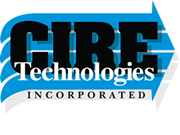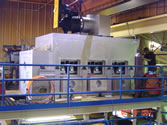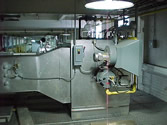Log in
Cire Technologies Blog
Principles of Direct Impingement Dryer Design Series – Paper No. 2 of 8
What is Direct Impingement Heat Transfer?
Direct impingement heat transfer uses air as an energy transferring agent to heat a product to change the product's properties to a more desirable product. In the converting industry this is often to dry a coating or print ink but is also used to change the properties of the product by heat treating. Direct impingement is usually done from one side of the product (web) but in some cases dryers utilize heat from both above and below the web.
The air is heated and blown onto the product much as a hair dryer heats and directly blows hot air to dry hair. As with a hair dryer, air in an impingement dryer is directed with a nozzle or nozzles at what you are trying to dry. The principles are the same, just as with a hair dryer, the closer the dryer is to the target the faster it heats up or dries. The hotter the air the faster the target heats up or dries. The greater the air flow the faster the target heats up or dries. And as with the hair dryer example, all these factors can be used to the dry the web quicker; although taken to extremes the product will be damaged by heating up or drying too rapidly.
The equation of heat transfer by the dryer is defined as:
q=H•A•(TA-TS)
Where: q=Heat transferred in Btu/(hr·ft2)
H=Heat transfer coefficient
A=Area in ft2
TA=Temperature of heating medium (air)
TS=Temperature of product surface temperature
So how do we rate the heating capability of an impingement dryer and how can that be used to characterize their performance capabilities?
The rate of heat transfer is measured by the heat transfer coefficient, H and is measured in Btu/(hr·ft2·°F), where °F is the difference in temperature between the heat source air (TA) and the target surface (TS). It should be noted that the target surface temperature will rapidly reach an equilibrium temperature while the liquid of the solution is evaporating and the surface of the product is still wet due to the evaporative cooling effect of the coating liquid. TS will remain at this temperature until the moisture is substantially removed after witch the heat necessary for evaporation has to be transferred to the plane of vaporization by conduction. The surface temperature rises rapidly at this point and for this discussion essentially marks the end of drying. In practical use the heat transfer coefficient H can be used to determine the amount of energy delivered by the dryer to a product to heat/dry it in a given period of time. For example:
If the heat transfer coefficient for a section of a dryer is 10 Btu/(hr·ft2·°F), the dryer is 10 feet long by 5 feet wide, the temperature differential (∆T) between the heated air and the product in the dryer is 100°F, and the product is in the dryer for 10 minutes, we can calculate the heat transfer that is provided by the dryer to the product as follows:
10 Btu/(hr·ft2·°F) x (10ft x 5ft) x 100°F x 10 min x 1hr/60min=8,333 Btu
Heat transfer coefficients for impingement dryers can range from as low as 1 Btu/(hr·ft2·°F) where very gentile heating is required to rates upwards of 30 Btu/(hr·ft2·°F) for very aggressive heating. Some products can be heated from both sides aggressively and can achieve even greater heat transfer rates.
In our next paper we will examine what process data is useful for the selection of the optimized impingement dryer design.
When you subscribe to the blog, we will send you an e-mail when there are new updates on the site so you wouldn't miss them.





Comments